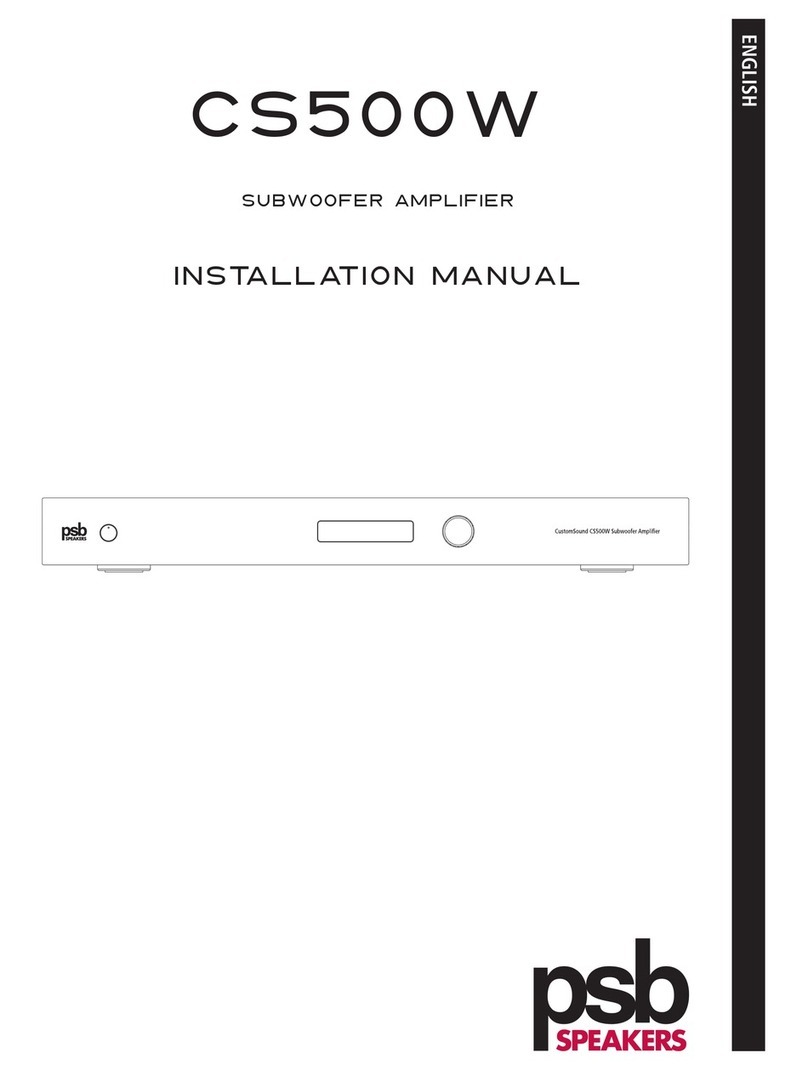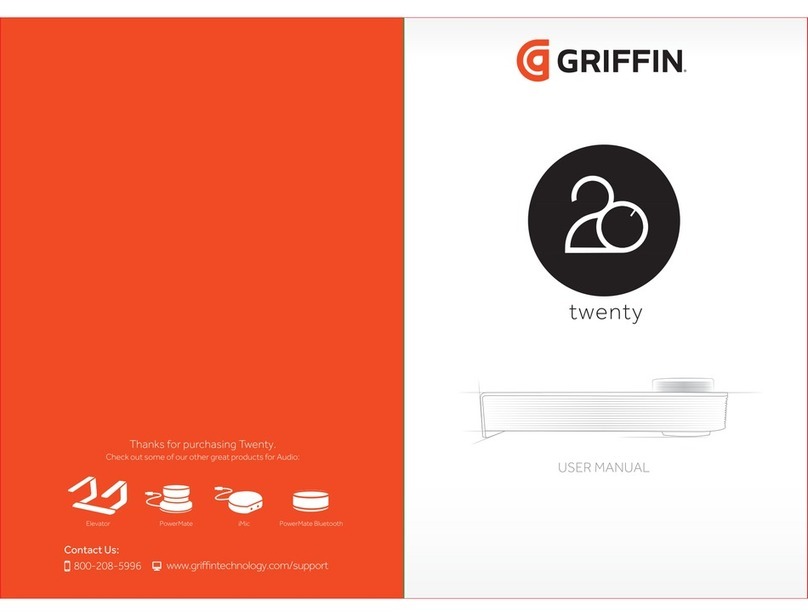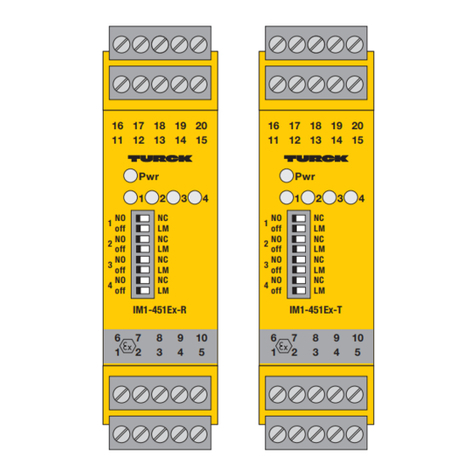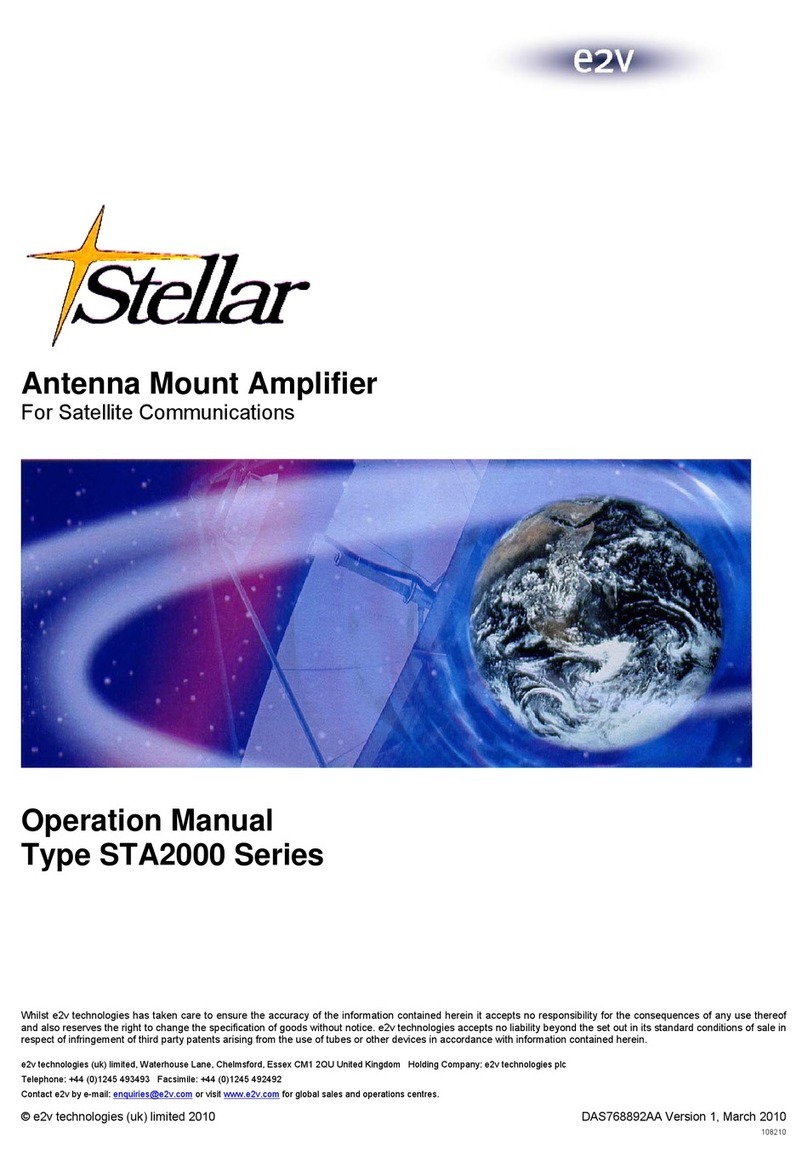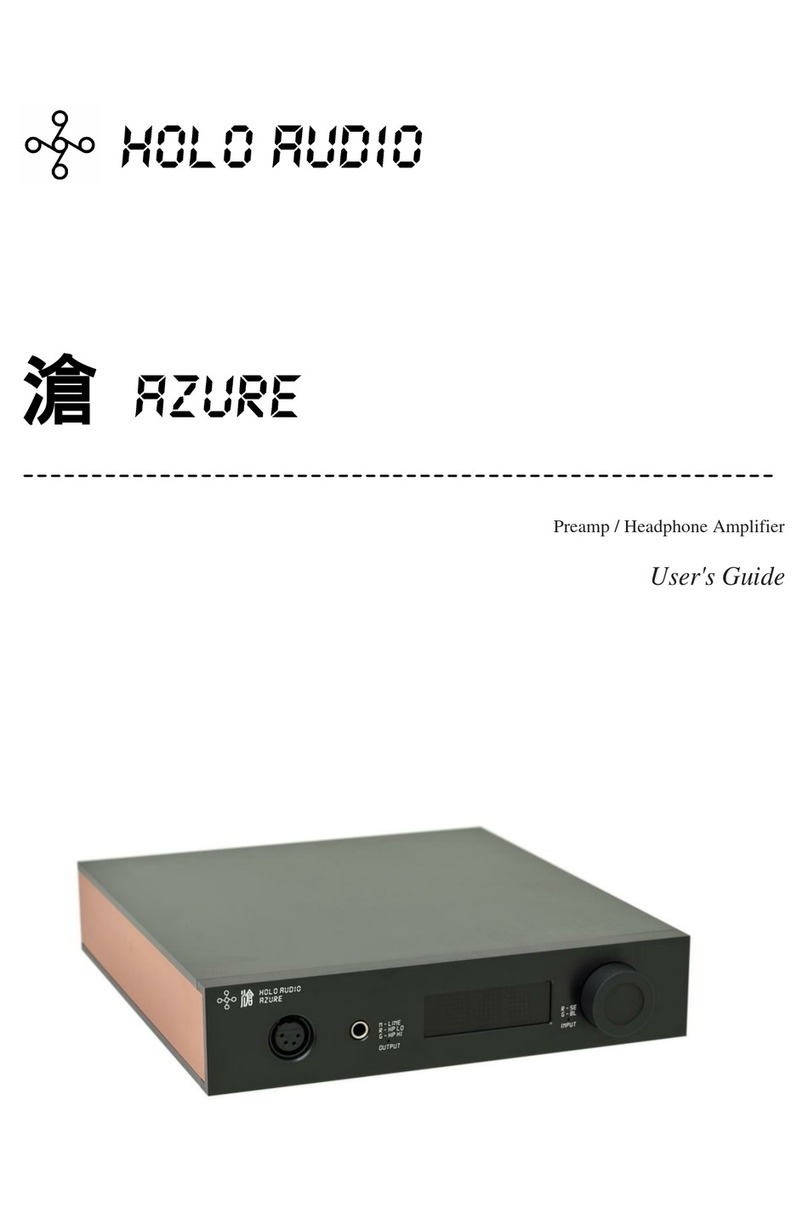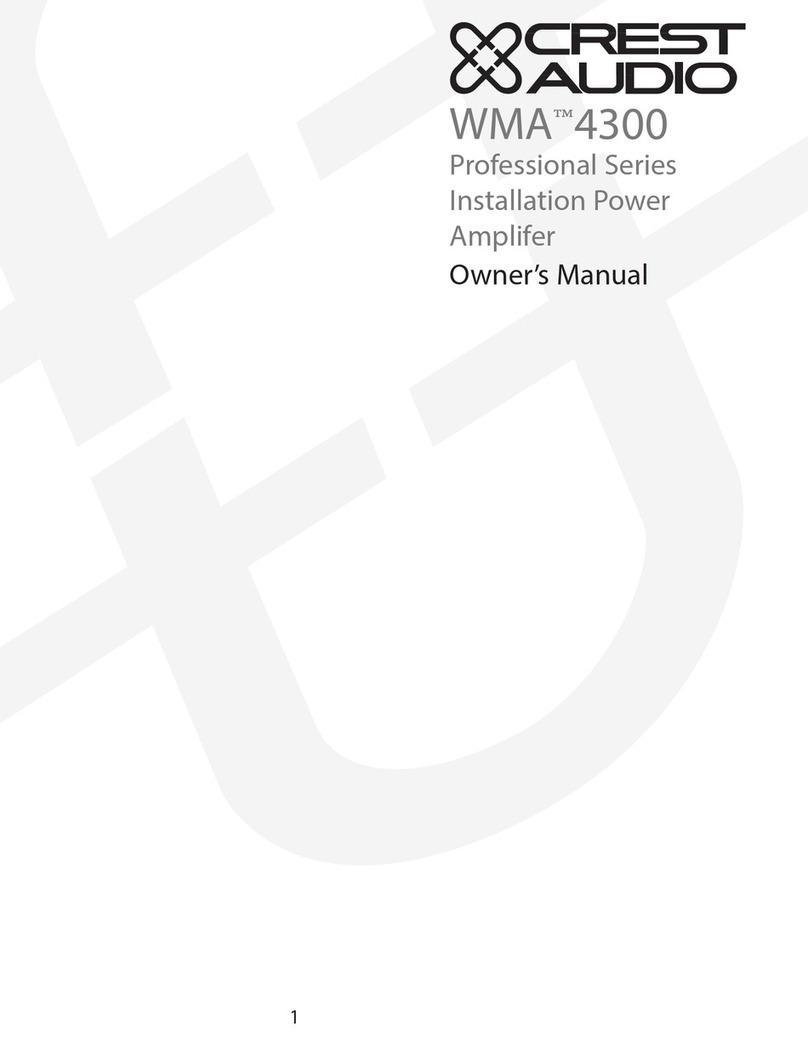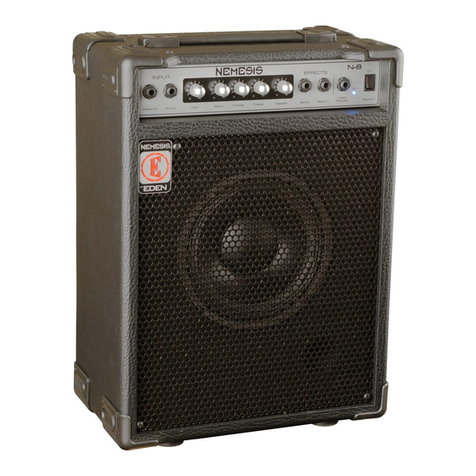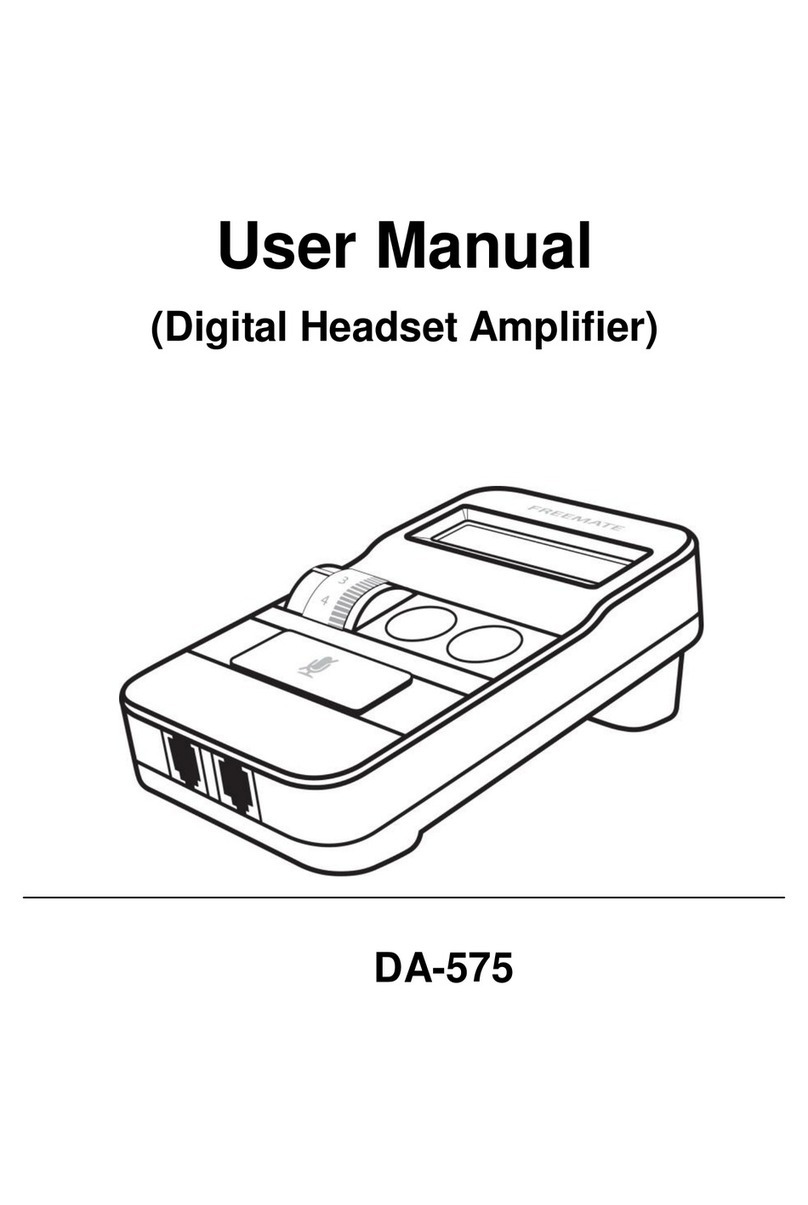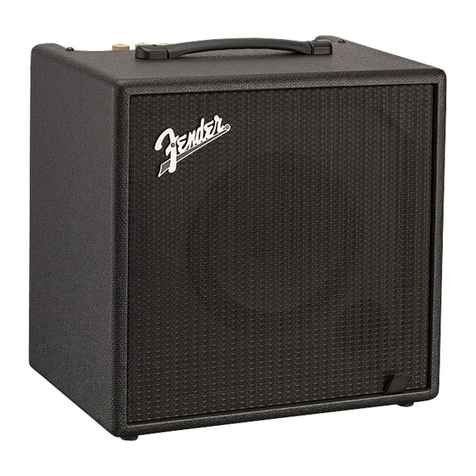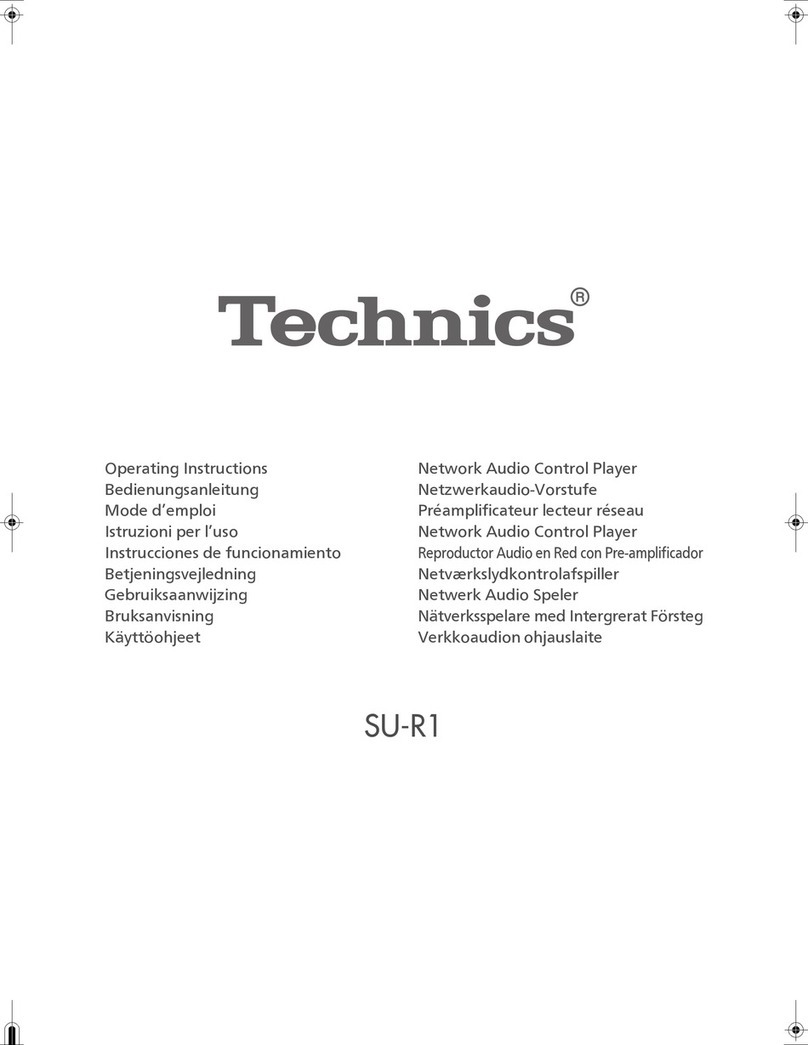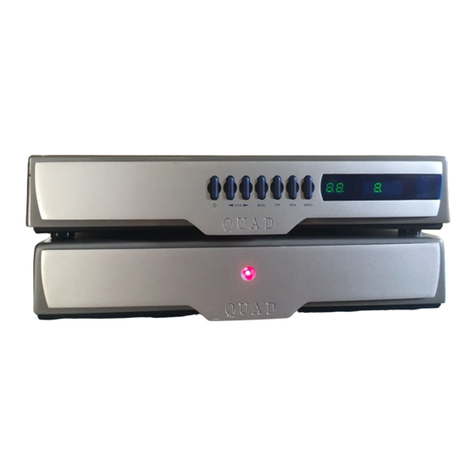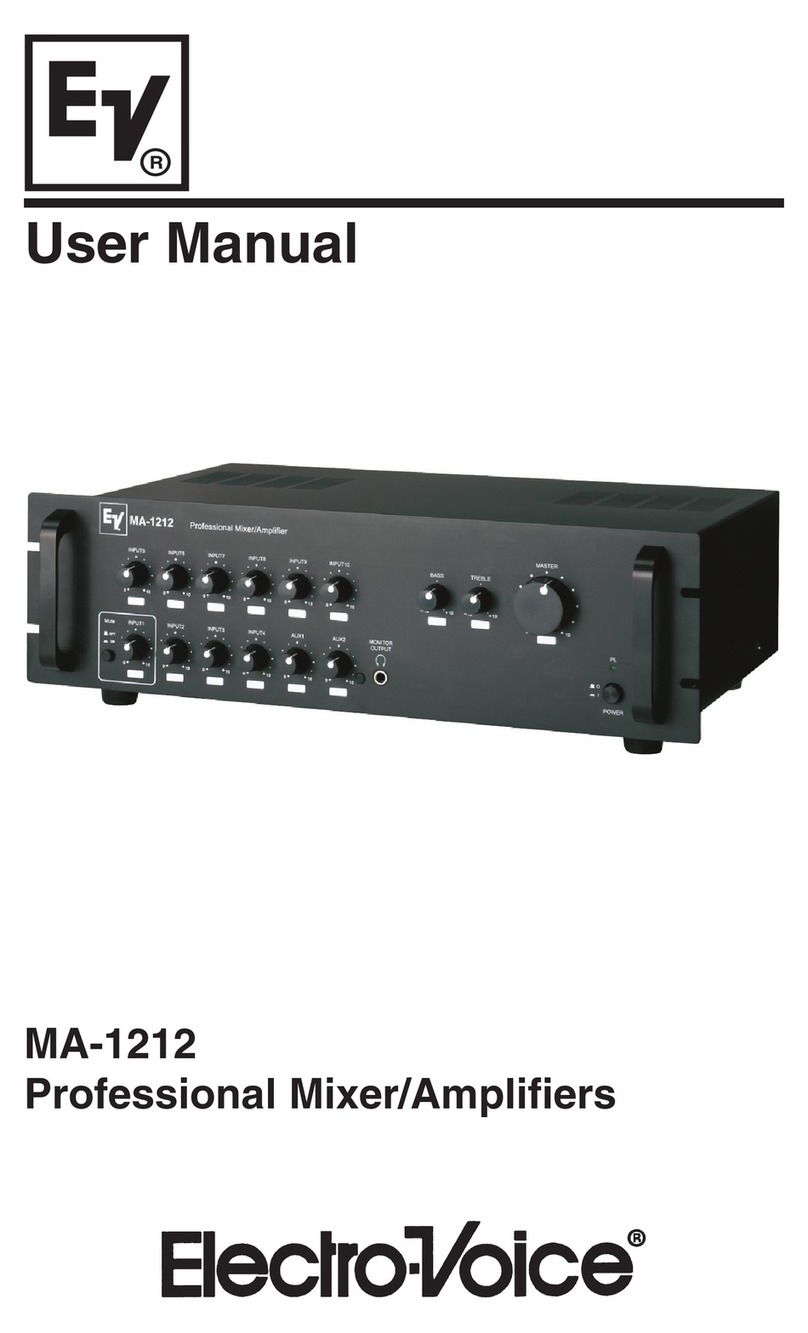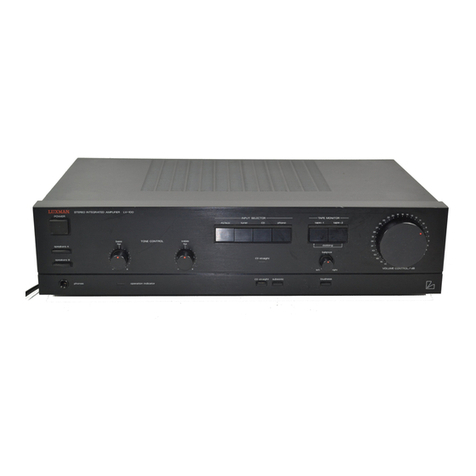PSB CWA-1 User manual

theCustomSoundseries
Installation Guide
CWA-1

CONTENTS
I. Important Safety Instructions
II. Introduction
III. Unpacking
IV. Warranty Registration
V. Chassis Care
VI. Quick Start
VII. Room Acoustics, In-wall Subwoofer Placement, Multiple Subwoofers
VIII.Controls and Connections
• Front Panel Controls
• Back Panel Control and Connections
• Accessing the Fuses
IX. Connecting Audio Components To The CWA-1 and Setup
• What You Should Know
• A Little Background
• Input and Outputs
• CWA-1 Block Diagram
• Connecting to the CWA-1 Using Stereo Preamp Line-Level Outputs
• Connecting the CWA-1 Using a Subwoofer/LFE Output
X. Setup and Calibration
• Adjusting the Parametric Equalizer
• Setting up the CWA-1 with a spectrum analyzer
• Setting up the CWA-1 by Ear
XI. In Case of Problems
XII. Specifications
2

I. Important Safety Instructions
1. Read these instructions.
2. Keep these instructions.
3. Heed all warnings.
4. Follow all instructions.
5. Do not use this apparatus near water.
6. Clean only with dry cloth.
7. Do not block any ventilation openings. Install in accordance with the
manufacturer's instructions.
8. Do not install near any heat sources such as radiators, heat registers,
stoves, or other apparatus (including amplifiers) that produce heat.
9. Do not defeat the safety purpose of the polarized or grounding-type plug. A
polarized plug has two blades with one wider than the other. A grounding
type plug has two blades and a third grounding prong. The wide blade or
the third prong is provided for your safety. If the provided plug does not fit
into your outlet, consult an electrician for replacement of the obsolete outlet.
10. Protect the power cord from being walked on or pinched particularly at plugs,
convenience receptacles, and the point where they exit from the apparatus.
11. Only use attachments/accessories specified by the manufacturer.
12. Unplug this apparatus during lightning storms or when unused for long
periods of time.
13. Refer all servicing to qualified service personnel. Servicing is required when
the apparatus has been damaged in any way, such as power-supply cord or
plug is damaged, liquid has been spilled or objects have fallen into the
apparatus, the apparatus has been exposed to rain or moisture, does not
operate normally, or has been dropped.
14. WARNING: To reduce the risk of fire or electric shock, this apparatus should
not be exposed to rain or moisture and objects filled with liquids, such as
vases, should not be placed on this apparatus.
15. To completely disconnect this equipment from the mains, disconnect the
power supply cord plug from the receptacle.
16. The mains plug of the power supply cord shall remain readily operable.
The lightning flash with arrowhead symbol within an equilateral
triangle is intended to alert the user to the presence of
uninsulated "dangerous voltage” within the product's enclosure
that may be of sufficient magnitude to constitute a risk of electric
shock to persons.
The exclamation point within an equilateral triangle is intended to
alert the user to the presence of important operating and
maintenance (servicing) instructions in the literature
accompanying the product.
3

II. Introduction
The PSB CustomSound series CWA-1 subwoofer amplifier is a complete solution
for powering and equalizing any in-wall or in-cabinet passive subwoofer. It is an
ideal companion for the PSB CWS8 in-wall subwoofer and any other custom
installed sub. When paired with the CWS8 the CWA-1 will deliver solid dynamic
bass for music and movie sound tracks.
The amplifier has a built-in variable crossover that makes it easy to achieve a
seamless blend with the main speakers, while 24dB/octave lowpass filters
prevent the subwoofer from being easily localized by the ear, increasing
placement flexibility. A crossover bypass position is provided for use with home
theater electronics that perform their own bass management functions.
Equalization is provided with two extension frequencies to suit large and small
subwoofers. A special feature is a parametric equalizer to help eradicate any of
the typical room related problems.
The CWA-1 is attractively housed in a standard 17 inch wide chassis that can be
adapted to a compact 2 space x 19-inch rack enclosure. Auto on/off and 12 volt
amplifier switching and easily accessible controls make the CWA-1 subwoofer
amplifier as convenient to use as it is exciting to listen to. It also utilizes a high
power discrete class AB output stage. The high current design allows continuous
operation into 2 ohm loads.
III. Unpacking
The packing materials of your PSB CWA-1 Subwoofer Amplifier are designed to
protect it from damage during shipping. Retain the packaging in case the need
arises to transport the amplifier in the future.
IV. Warranty Registration
We recommend you take a few moments now to register your warranty,
preferably on-line at psbspeakers.com/w/Warranty.html or via the enclosed
registration form so that we will be able to serve you better in the future.
V. Chassis Care
The chassis has varying materials and finishes including painted sheet steel and
painted anodized aluminum parts. They should be treated as you would any
other electronic equipment with similar finishes. Dust lightly with a soft cloth;
avoiding abrasives. If necessary, wipe carefully with a cloth slightly dampened
with glass cleaner to remove heavy soil.
4

VI. Quick Start
If you cannot wait to hear your new PSB subwoofer amplifier: Turn off all other
components, and follow one of the connection diagrams. Connect the supplied
power cord to the AC power socket. Set the PSB subwoofer amplifier volume
control to its minimum position (counterclockwise), then plug the amplifier into an
active AC outlet. The same receptacle as the rest of your audio/video system or
another on the same electrical circuit should be used to avoid ground hum. Set
the amplifier's Sub Cut-Off Frequency control to its midpoint, the Parametric
Equalizer Boost/Cut at 0dB, the Low Frequency Cutoff at 45Hz and the phase
switch to +. Flip the Power Switch to the ON position. Play a bass-rich program
source, and slowly bring up the Sub Volume control (clockwise) until the
subwoofer contributes a natural level of low frequency sound. Now please read
the rest of this guide and fine-tune your installation accordingly—it will be time
well spent!
VII. Room Acoustics, In-wall Subwoofer Placement, Multiple
Subwoofers
Room Acoustics
Since the earliest days of high fidelity, one of the main challenges for the
designers of speakers, and of their users, has been management of the lowest
frequencies of deep bass. Many of the most notable developments in speaker
design have been made with a view to getting more bass output from smaller
boxes.
One consideration is the size of the listening room. The larger the volume of air a
speaker must excite, the more acoustic output you will require from it to achieve
the sound levels you want. In any environment, sounds attenuate as you move
farther away from their source, but in smaller rooms that tends to be offset by
reinforcement from wall reflections. The larger the space is, the farther the sound
has to travel both to reach the reflecting surfaces and then to get to your ears,
which means it has to be louder to begin with.
With traditional full-range speakers, that involves an intricate matching act
between amplifier power, speaker sensitivity, impedance and power handling.
But the bulk of the power goes to reproducing bass, so the use of powered
subwoofers and separate midrange/treble satellites both allows you to be
conservative in the amount of power your main amplifier produces, and ensures
a good match between the low-frequency amplifier and the woofer it is paired
with.
After size, the most important aspect of a listening room is its shape. In any room,
sound reflects off the walls, ceiling, and floor. If the distance between two
opposite parallel surfaces is a simple multiple of the wavelength of a particular
frequency, notes of that frequency will bounce back and forth in perfect
phase—an effect called a standing wave or room mode.
At some point in the room, this note will be reinforced substantially; at others it
will cancel out almost entirely. If the prime listening seat is placed at either of
these locations, the note will be a horrible boom or virtually non-existent. The
standing waves are different between floor and ceiling, side walls, and end walls,
5

unless any of these dimensions are the same. An ideal listening room would
have no parallel surfaces—an unusual situation, to say the least—so that such
waves would not establish themselves. The worst kind of room is a perfect cube.
Almost all rooms are susceptible to some standing waves at low frequencies, but
their effects can be minimized by careful positioning of both the speakers and the
listening seat. Moving either of these even a few inches is sometimes enough to
cure—or create—an intolerable sound. The only way to find out what works best
is by experimentation.
With full-range speakers, the range of places you can put the speakers and still
get proper imaging may be fairly limited, and some of these positions may result
in standing waves that can't be tamed. Things are more controllable through the
use of a subwoofer or two. Positioning of the bass speakers has almost no
impact on imaging, so a subwoofer can be located with only standing waves in
mind.
In-Wall Subwoofer Placement
The CWA-1 can be used with nearly any passive subwoofer. This includes the
PSB CWS8 in-wall subwoofer as well as future models, both in-wall and
enclosed. Obviously an in-wall subwoofer must be located on the wall surface
while a conventional subwoofer allows more freedom of location. There is no
argument among audiophiles that the loudest bass output from a subwoofer
comes from corner placement. The natural megaphone-like flaring outward of
walls from a room corner focuses low frequencies—giving them no place to go
but toward you. In the case of subwoofers, there is no automatic penalty in giving
overall balance for this maximal bass, since your main speakers can be located
elsewhere. Unless you are seated in a “null” spot, where sound from the sub is
cancelled or diminished by out-of-phase reflections from elsewhere, there should
be plenty of bass from corner placement.
If you are seated in such a null spot, your only real choices are generally to move
either the subwoofer or your listening position until bass returns to the point that
satisfies. Cranking up the level control or changing the crossover point almost
certainly won't help much. But flipping the phase control 180 degrees sometimes
may make a difference, especially if the null is a product of cancellations caused
by interaction with low frequencies from your main speakers
If you are in the opposite sort of situation, where direct and reflected bass waves
converge in phase and produce a strong peak at your listening location, you
Most bass output,
even bass response
Moderate bass output,
more even bass response
6

can—if you like—deal with that both with changes in placement or in the position
of your sub's level control (or, less likely but possible, the crossover frequency
chosen). We say “if you like” because there is no such thing as too much bass for
some listeners, and we don't want to be dogmatic. You are definitely the one who
has to be pleased, unless your Significant Other chimes in to the contrary.
As you go outward from the corner along the wall, the general consensus (with
which we tend to agree) is that while bass output diminishes somewhat, it also
becomes more uniform throughout the room, with fewer of the “standing waves”
that produce peaks and nulls at various points.
Chances are things won't be so simple, so the best method for positioning a
subwoofer, although a rather undignified-looking one, is to put a conventional
enclosed subwoofer in your listening chair, then play music with lots of bass
through the system, something with steady low frequencies (such as organ
music) or continuous test tones, not movie material. Move around the perimeter
of the room and note where the bass sounds best; if you place the in-wall
subwoofer there and yourself in your chair, you should get the same bass
performance. Bear in mind that the test only works if you have your ears as high
off the floor as the subwoofer will be, so don't be afraid to crawl around. A simple
recommendation for the placement of an in-wall subwoofer would be in either of
the front corner walls of the room (on either side of the main speakers).
Multiple Subwoofers—Why Two Subs Are Better Than One
Since the objective of most people who buy subs is to make sure of plentiful low
frequencies, the only situation most of us will run into that makes subwoofer
placement really difficult is the factor we all fear - the “bad” room that just won't
let you get satisfying amounts or quality of bass. There are rooms with
troublesome dimensions, especially as you approach a perfect cube (with a
closed door). There is unlikely to be any combination of speaker and listener
position that will be free of obvious acoustic anomalies.
In such a case, the best way to iron out those anomalies is with two subwoofers,
placed carefully to work with each other. This can also be true when the problem
is too much, or too uneven, bass. The overall system needs all the help it can get,
and that often means the use of two subwoofers, each one of which corrects for
the acoustic problems excited by the other. Recent studies have shown that two
subwoofers placed in the center of two opposite walls so that the subwoofers and
listening area are on a line, will give the smoothest possible bass performance.
The two opposite walls could be the left and right walls or the front and back
walls. It may be fine to use two lesser subs to equal the performance of one with
stronger specs.
7

8
VIII. Controls, and Connections
Front Panel Controls
C. PARAMETRIC
EQUALIZER
Boost/Cut
Adjusts the amount of
equalization; determines
if the band of frequencies
will receive amplification
or attenuation. Setting
the control to “0dB”
effectively removes the
parametric equalizer
from the circuit.
Bandwidth Knob
Adjusts the width of the
frequencies to be
affected.
Frequency Knob
Adjusts the center of the
band of frequencies that
will be primarily affected.
D. LOW FREQUENCY CUTOFF Switch
Adjusts the lowest frequency that the CWA-1
will direct to the subwoofer.
E. PHASE switch
Switches the polarity of the speaker output(s). Experiment
with this setting. The correct setting is that which yields the
fullest bass.
F. CROSSOVER FREQUENCY Knob
Adjusts the lowpass crossover point and thus the upper
frequency range of the CWA-1. This should initially be set
to a frequency equal to the low end response of your main
front speakers (consult your speaker manual for this
information).
G. VOLUME Knob
Sets subwoofer volume level. Start at ‘5’ and then adjust
upward or downward as required to achieve an
appropriate bass level. If extreme settings are required,
check your processor’s LFE or subwoofer gain settings.
A. POWER switch
The power switch turns the
CWA-1 on and off. As the
CWA-1 draws only an
extremely small current when
in standby, this switch may be
normally left on and turned off
only when you do not expect to
use the amp for an extended
period. The power switch must
be in the on position for normal
operation. Press the upper half
of the switch to turn on the amp
and the lower half to turn it off.
B. LED indicator
Amber - standby
green - ON
red - protection
The LED indicator will not light
up when the amplifier is off.

9
Back Panel Controls and Connections
H. LINE LEVEL STEREO
INPUT/OUTPUT Jacks
Connect to the subwoofer or
LFE output of your receiver or
processor, a separate
component preamplifier, or to
an integrated amplifier or
receiver with preamplifier-
out/main-in facilities. Low level
outputs are high pass filtered
with a fixed crossover frequency
of 80Hz. See IX. Connecting
Audio Components To The
CWA-1 and Setup
I. LINE LEVEL XOVER
BYPASS/ LFE INPUT Jack
Connect to a receiver/processor
with an LFE output and/or
internal low pass filter See IX.
Connecting Audio Components
To The CWA-1 and Setup.
J. 12-volt TRIGGER switch
ON Position - Amp is on
whenever the front panel
switch is in the ON position.
EXT. TRIG - Amp begins in
standby mode whenever the
front panel switch is in the
ON position. The CWA-1
turns on when a 12-volt
power supply triggers it. Be
sure to use a power supply
that is rated as "9 to 14 volts
DC. Observe polarity as
marked.
MUSIC Position - Amp is in
standby mode whenever the
front panel switch is in the
ON position. The CWA-1
turns on when an audio
input signal triggers it.
K. TRIGGER terminal block
IN - connect to the source of your 12V trigger.
Set 12V trigger switch to EXT TRIG position
OUT - connect to other components requiring a
12V trigger
Note: the terminal block can be removed to
simplify wiring by giving it a firm tug.
L. SPEAKER terminals
Connect one or two subwoofers to these
terminals. Note that these outputs are wired in
parallel and the total parallel impedance of two
subwoofers should not be less than 2 ohms.
M. AC POWER Socket
Supplies AC power to the CWA-1. Connect the
supplied power cord to the AC power socket.
Plug the power cord into any standard wall
outlet. With 230 volt versions, in some countries
it may be nessessary to replace the power cord
to meet the standards locally in use.

Accessing the Fuses
Disconnect the power cord and input/output wires. Turn the amplifier upside
down and lay it on its top. Remove two Phillips screws used to secure the fuse
cover panel located on the bottom panel below the power cord socket.
Locate the two fuses (F1 & F2) inside the opening (as shown below). Remove
and check both fuses. The fuse is definitely damaged if the inside element is
broken or if the glass is discolored. If there is still any doubt, check the fuses with
a multi-meter. Replace with the same type fuses as required.
The replacement fuse for the CWA-1 is a T2.5A 250V, Size: 5x20mm.
Reinstall the fuse cover panel and the two Phillip screws. Return the unit to the
upright position and reconnect the AC cord. If the LED indicator still doesn’t
illuminate, the amplifier requires service by an authorized PSB Speakers Service
Technician.
10
Front of CWA-1
F1
F2
Fuse Access Opening

IX. Connecting Audio Components To The CWA-1 and Setup
What you should know
Connecting your CWA-1 is straightforward but there are a number of system
variables that may confuse the issue of how best to connect the CWA-1 and what
settings your other equipment will need in order for the full system to work at its
best. In this section we will discuss some of the variations, both in wiring and
settings, and then give concrete examples of how to connect your CWA-1 into
the most frequently encountered systems.
In all systems the CWA-1 comes next in line after your system processor. This
processor may be a stereo preamplifier or receiver or it may be a 5.1 (6.1 or 7.1
as well) AV processor or receiver. Whatever the preceding piece of equipment
we will want to get an isolated bass signal from it to drive the CWA-1 or get 1 or 2
full range channels from the processor that we can filter the bass from.
In the case of stereo (2 channel systems) most processors don't have subwoofer
outputs and we will use the internal filtering of the CWA-1. This means that the
left and right channels can be fed to the CWA-1's LINE LEVEL INPUTS, the
CWA-1's LINE LEVEL OUTPUTS would then have the stereo signal minus all
bass below 80Hz. This signal will be returned to the power amplifier or the power
amp section of the receiver for ultimately driving the main left and right speakers.
Conversely, most multichannel processors have subwoofer outputs and
provisions for bass management. Bass management is a fancy term for the
various options that determine, for different kinds of signals (stereo, Dolby pro-
logic, or Dolby Digital) and different speaker configurations (large or small
speakers, subs or no subs) where the bass is routed to.
A little background
Digital 5.1 source material (Dolby Digital or DTS) has a separate bass track
usually reserved for movie explosions and rumblings. This is called the LFE
(Low Frequency Effects) or .1 channel. The other 5 channels are full range as
well and will all have some bass content, such as the background music of a
movie or perhaps all the bass content of a music video.
When a subwoofer is present we may want to route the bass from all channels to
the subwoofer. If the power handling of the front and surround speakers is
limited, then this is certainly the case. In some systems an owner will have a
preference for sending only the .1 effects bass to the subwoofer and allowing the
bass from other channels to carry on to their respective channels. This might be
the case where the front channel speakers are full range and, we like their bass
character on music, as an example. Such variations are handled by the
processors Bass Management options usually by designating the various
channels as “large” or “small”. These code names simply mean: “Send the bass
of this channel to its respective speaker” in the case of large, or “No, send the
bass of this channel to the subwoofer output”, in the case of small.
The main points to be emphasized are that the processors settings must be set
such that no bass content is lost and at the same time speakers that might not be
able to handle heavy bass content have it diverted to the subwoofer. The best
approach is to study the owners manual of the processor and, based on the
discussion above, to make the appropriate settings.
11

Inputs and Outputs
For receiving and sending a signal back and forth between the rest of the system
the CWA-1 uses line level inputs and outputs. These are at the intermediate
levels found just prior to amplification to the power required to drive a
loudspeaker.
There are three inputs to the CWA-1: one stereo pair is marked simply “INPUT”
while a third jack is labeled “X'OVER BYPASS, LFE INPUT” The distinction
between these two input types are that signals connected to the X'OVER
(crossover) BYPASS input do not go through the CWA-1's variable filter. In the
case of using this input the front panel control labeled CROSSOVER
FREQUENCY is not in circuit. All other controls (PARAMETRIC EQUALIZER,
PHASE, etc.) are still in circuit. The X'OVER BYPASS input will only be used if
frequency filtering is in the preceding processor and you want that to be the only
filtering in circuit.
Signals sent to the other jacks (INPUT) will have any low frequency content
summed. That is, bass from the left and right channels of a stereo signal will be
combined for the one subwoofer. It is perfectly acceptable to connect a single
filtered subwoofer or LFE signal to these inputs in which case either the Left or
Right channel input can be used with exactly the same effect.
A final pair of line level jacks are marked “OUTPUT”. These contain the Left and
Right Input signals but with the bass content filtered below a fixed crossover
frequency of 80Hz. Although the bass is mono combined, these outputs maintain
full stereo isolation. Note that if the X'OVER BYPASS input is used no signal will
be present at these outputs.
Toward the right side of the amplifier are the Subwoofer output 5-way binding
posts marked “SPEAKER”. These binding posts are for the speaker level
connection to one or 2 subwoofers. The two red (+) and black(-) binding posts
are in parallel. The CWA-1 will drive down to 2 ohms so it is permissible to
connect two 4 Ohm subwoofers in parallel through these posts for a combined
impedance of 2 Ohm.
12

13
LEFT
RIGHT
VOLUME Low Frequency
Cutoff
30 45
LEFT
RIGHT
80 Hz
High Bypass Filter
Parametric EQ
Boost/Cut
Bandwidth
Frequency
PHASE Switch
Power
Amp
Trigger
In Out
ON
EXT VOLTS
MUSIC
Line Level
Stereo Inputs
Crossover
Frequency
XOVER BYPASS
LFE INPUT
Line Level
Stereo Output
Speaker
Level Output
INPUT
OUTPUT
SPEAKERS
CWA-1 Block Diagram

Connecting to the CWA-1 Using Stereo Preamp Line-Level
Outputs
Connecting from: Stereo preamp or receiver
Benefits: Subwoofer operation with all sources
Challenges: Bass to the main speakers not limited
Best Preamp or Receiver Settings Best Settings for CWA-1
Subwoofer = No Crossover Frequency = 80 Hz
Front Channels = Large
Center and Surround Channels = Small
CWA-1
Pre-amplifier
Receiver CWS8
4W
Pre-amp Out
Power Amp
Speaker R Speaker L
Input/Main In
R L
4W4W
4W4W
Optional
Optional
Pre-amplifier
Receiver
Pre-amp Out
Power Amp
Speaker R Speaker L
Input/Main In
R L
R L
R L
14

Connecting to the CWA-1 Using a Subwoofer/LFE Output
Connecting from: Dolby Pro Logic Digital 5.1, 7.1 Receiver or Processor
Benefits: Simplest Connection
Challenges: Some receivers may not send information to this output
when in stereo mode while playing back CDs, records, VCR,
or stereo satellite receiver
Best Preamp or Receiver Settings Best Settings for CWA-1
Subwoofer = Yes Crossover Frequency = 80 - 100 Hz
if using Subwoofer Output into
Front Channels = Small CWA-1 L or R Input if
Crossover Frequency (where applicable) = Receiver/Processor does not
as desired; 80 - 100 Hz recommended contain a subwoofer crossover
CWA-1
Sub/LFE Output
Receiver or Processor
with Internal Crossover
Subwoofer Out
Receiver or Processor
without Internal Crossover
Optional
Optional
CWS8
CWS8
4W
4W
15

X. Setup and Calibration
If you are critical about low-frequency response, there's quite a bit of useful
experimentation you can do, especially in combination with the crossover, level,
phase and parametric equalizer controls of the CWA-1.
Adjusting the Parametric Equalizer
A unique feature of the CWA-1 is its parametric equalizer. No matter how good
the subwoofer, bass response is usually strongly compromised by the
dimensions and material properties of the typical listening room. With the
CWA-1's parametric equalizer you can isolate the worst problem of the room and
equalize it to flat, thereby much improving bass accuracy and naturalness. Unlike
the commonly encountered graphic equalizer, a parametric equalizer allows full
control of frequency, bandwidth and amount (boost or cut) of equalization.
The CWA-1's equalizer, as well as its other controls, can be set by ear or via a
spectrum analyzer. Instructions will be given for both methods in the following
sections:
Setting up the CWA-1 with a spectrum analyzer
A spectrum analyzer will usually be a “real time” 1/3 or 1/6th octave analyzer.
Typically pink noise is sent through the system and a microphone is placed at the
center of the listening area. The system response can then be viewed on the
spectrum analyzer. Feeding pink noise through the system processor or AV
receiver will feed front channels as well as the subwoofer and will allow
optimization of all of the CWA-1's crossover controls. The best method is to feed
the spectrum analyzer to the processor via a “Y” connector to any pair of analog
inputs (left and right). To control which channels are driven, switch between
normal stereo and Dolby Pro Logic. When in Pro Logic the processor will steer
the input to the center channel and subwoofer only. When in stereo, the pink
noise should come out of the front left, front right and the subwoofer (bass
management settings permitting).
Each control will impact a particular bass area. Look for the following response
effects and make adjustments as needed.
CROSSOVER FREQUENCY will determine the upper frequency where the
CWA-1 and subwoofer roll off. This frequency needs to be a good match to the
lower frequency cutoff of the front speakers. If the front speakers are rolled off
beginning at 80Hz then the subwoofer will need to match that. You will see that
raising the crossover frequency above that frequency will cause overlap of
woofer and front speakers and will give more energy around 80 Hz. Turning the
crossover frequency lower will reduce the total energy around 80 Hz and may
even create a response hole.
At the same time try the PHASE (+-) switch in both positions. Usually one
position will give more level in the crossover region. This is the setting that gives
the best phase match between subwoofer and fronts. Try this with both the left
and right front speakers on, and also with just the center on. Leave the switch in
whichever postion gives the most level of mid-bass energy, even if the response
mounds up above flat, then readjust the crossover frequency for flattest response
in the crossover region.
Set the bass level (via the large VOLUME knob) so that it is some amount
16

greater than the average level of the front speakers. This is a matter of taste and
experience but most listeners (on most programs) like the bass level when the
average bass level is about 6dB higher than the midrange level.
Now, unless you have an extraordinarily good room, you will see a number of
peaks and dips in the bass regions below the crossover point. We will adjust the
PARAMETRIC EQUALIZER to flatten the worst of these issues. As a general
rule peaks are more audible than dips, however a very wide dip will reveal itself
as a “lacking” or a “hole” in some bass region. It is a good idea at this time to
listen to some program material that you are familiar with having heavy bass
content and see subjectively what the worst room effect is. Once that is decided,
set the FREQUENCY knob first. You may use the frequency numbers marked on
the CWA-1 but confirm that they are the best setting by swinging the setting a bit
above and below while watching the spectrum analyzer. Start with the Q set to
maximum and the boost/cut control at maximum (+10 if you intend to fill in a dip, -
10 if you want to fix a peak.) Slowly turn the frequency control up and down. You
will then easily be able to see when the equalizer frequency is set to match the
aberration. Once the frequency is well aligned, adjust the boost or cut until the
peak or dip is at the average bass level. Vary the bandwidth control until the
flattest response through that region is achieved. A little iteration back and forth
between the controls may be required for the best result.
Note two things: This room response will vary with listener position. Move the
microphone around the listening area to make sure that improvements for one
seat haven't made things worse for other seats. Secondly, over correction of
room effects can be worse than under correction. Half lowering a peak or half
filling in a dip can often sound very good. Once the frequency, bandwidth and
boost/cut are set it is recommended that you listen to music and try other
amounts of boost or cut (leaving the other two controls fixed).
Setting up the CWA-1 by Ear
If you don't have access to a spectrum analyzer you will follow all the procedures
above using the spectrum analyzer between your own two ears!
This is not as hard as it first seems. Start with selecting an item of program
material with a varied but persistent bass track. It can be helpful to pick a section
and use an AB repeat function to allow 10-30 seconds of it to repeat over and
over. Make adjustments with 2 people, one in the center of the listening area
calling the shots, and another adjusting the CWA-1 settings as requested.
Set the bass level to approximately the right level via the VOLUME knob and
then alternately try the PHASE switch at the + and - positions. Listen for the
amount of upper bass between the two positions. Even if it sounds like too much,
leave the switch in the position with the “fuller” mid-bass.
Now use the CROSSOVER FREQUENCY adjustment to fine tune the crossover
region. First set the knob to the frequency that corresponds to the lowest
frequency that the front speakers either naturally respond to, or are forced to roll
off at because of a high-pass filter in the processor or AV receiver. If you're using
the low level OUTPUTS of the CWA-1, don't forget that they are high pass filtered
and the crossover frequency is fixed at 80Hz. Then, if there seems to be too
much upper bass, lower the crossover frequency bit by bit. At the same time,
make adjustments to bass level. The bass VOLUME knob will effect all bass
frequencies, the CROSSOVER FREQUENCY will adjust the level of upper bass
17

18
frequencies. The right settings for both will give a proper balance between lower
bass frequencies (bass “weight”) and upper bass frequencies (“sock” or “kick”).
Adjust to a sound you like but remember that, in the long run, it will be best to
have a setting that gives a natural amount of bass rather than an exaggerated
amount. Like spice with food, bass is best when it enhances and doesn't
overwhelm.
Just following the procedure as outlined so far should result in a well balanced
bass level and character. Still, some serious listening will probably reveal some
bass region where the PARAMETRIC EQUALIZER will further improve matters.
Listen for any bass notes that seem out of proportion and “drone” or “overhang”.
These will be peaks that can be reduced with the PARAMETRIC EQUALIZER.
Conversely, if some notes seem artificially subdued then the Equalizer can be
used to boost the region. Pick the most offending aberration and use the
PARAMETRIC EQUALIZER to correct it. In the example of reducing a peak, you
must first match the equalizer to its frequency. You might find it easiest to find
that frequency by dialing in boost (even though that will exaggerate the problem):
Set the BANDWIDTH to a low value (0.2 to 0.4) and slowly swing the
FREQUENCY knob back and forth. When the frequency of the Equalizer and
the frequency of the room peak match then the peak will be even more obvious.
Once this frequency is found then you will obviously want to shift the
BOOST/CUT setting from boost to cut (+ to - ). Try different settings of
BOOST/CUT and the BANDWIDTH knob until the most natural and even bass is
arrived at.

19
Action
Ensure the main power switch is toggled to the “on” position.
This switch is located at the front of the amplifier.
Ensure the power cord is connected to the amplifier and
plugged into a live AC outlet.
Check the main fuses accessable from the bottom of the
amplifier via the fuse cover. See Section VIII. Controls and
Connections. Replace as required. If the new fuse also blows,
the subwoofer amplifier requires service.
Ensure the amplifier's volume control is NOT in the minimum
counterclockwise position.
If the trigger switch is in the “music” position, signal sensing
auto on/off circuitry is engaged. If no signal is sent to the
amplifier, it will not power up and the front panel power indicator
will not illuminate green. When using the subwoofer output of a
receiver or processor, no signal may be immediately present in
this output. The amplifier will only power up when bass appears
at the subwoofer output.
If the low level cable or speaker cable connection is poor or has
been severed, the amplifier will not power up. Swap cables or
turn the trigger switch to the “on” position to determine if this is
the source of the problem.
Lower volume if the subwoofer begins to sound distorted to
determine if playback at a lower level solves the problem. If a
slight reduction in level solves the problem, were you being
realistic in your subwoofer level setting? If the distorted sound
remains at a low level, one or both of the woofers may be
damaged.
Hum that appears when using the amplifiers' low level input(s)
is usually caused by using an inferior, damaged, exceptionally
long low level cable or cables routed near high current wiring/
appliances. Replace/ shorten the low level cable connecting the
subwoofer to the source equipment (receiver or processor). Low
level cable runs of longer than 50 feet may require the use of a
line driver (not available from PSB).
Decreasing the volume control of the CWA-1 and increasing the
volume control of the receiver/processor/amplifier subwoofer
output can sometimes reduce hum to an acceptable level.
Symptom
No
sound/power
and indicator
LED not lit.
XI. In Case of Problems
See your dealer if you require service. PSB dealers are equipped to handle
almost all problems. If you have moved since your purchase, the nearest
authorized PSB dealer should be able to help you. You may locate your nearest
PSB authorized dealer on-line at www.psbspeakers.com/r/list.html. If the
problem is not resolved, please contact us, providing the Model name, Serial
Number, date of purchase, dealer name, and a full description of the problem.
Indicator LED
will not change
to green.
Sounds
distorted
Hum

20
XII. Specifications
Amplifier Power
Continuous 200 Watts into 4 ohms, 300 Watts into 2 ohms
Dynamic 350 Watts into 4 ohms, 500 Watts into 2 ohms
Crossover
Frequency Range 55 to 150 Hz
Filter 24 dB/Octave Lowpass
Parametric Equalizer
Boost/ Cut -10 dB to +10 dB
Bandwidth 0.15 Octave to 1.05 Octave
Frequency 30 to 100 Hz
Inputs
Stereo Line Level RCA
LFE Line Level RCA
Trigger In
Outputs
Stereo Line Level RCA
Speaker x 2
Trigger Out
Dimensions (W x H x D)
Net 17” x 12 5/8” x 3 ¾” (432mm x 321mm x 95mm)
Shipping 21 ½” x 6 ½” x 13 7/8” (547mm x 167mm x 352mm)
Weight
Net 18.0 lbs (8.2kg)
Shipping 20.9 lbs (9.5kg)
Volume
Shipping 1.12 cu.ft. (0.03 cu.M.)
Finish
Black
Features
2 ohm stable operation
Controls for Level, Low Pass Frequency and Phase
Two EQ/extension positions for current and future subs
Three control Parametric Equalizer
Music or voltage sensor triggering
Shelf mounting
Other manuals for CWA-1
1
Table of contents
Other PSB Amplifier manuals
